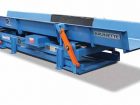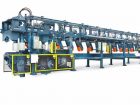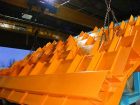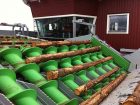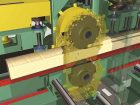
Features
Mills
Sawmilling
Infeed systems
October 20, 2015 - Sawmills, particularly mills that are undergoing rebuilds, are focusing more than ever on boosting efficiencies across all areas. One area getting a closer look these days are log and saw line infeed systems.
October 20, 2015 By Treena Hein
 SmartVibe vibrating conveyors allow operators to easily change the infeed speed while the conveyor remains completely balanced. Sawmills
SmartVibe vibrating conveyors allow operators to easily change the infeed speed while the conveyor remains completely balanced. SawmillsWhen it comes to log infeed systems, there will be a continued need for the systems to handle more throughput so that they’re able to keep up with processing equipment as it evolves, says Mike Stelter, manager at Linden Fabricating.
“In Canada especially, many lumber producers are bringing in cut-to-length logs versus tree-length logs,” Stelter says. “This way, lumber producers are able to reduce slower throughput and increase production.”
“Infeed systems used to be second-thought products that were worked in after the primary breakdown equipment, but mills are now beginning to look at the entire system as a whole, and looking to make every single square foot of their mill as efficient as possible,” adds Aaron Candido, head of marketing and business development at Murray Latta Progressive Machine.
One of the reasons infeed systems are being redesigned is to reduce their overall size.
“There have been many changes in the design of infeed systems to reduce their length,” says Comact marketing manager Anne-Marie Lévesque. “The shorter the infeed system is, the less time the log has to fall on its side. You also get a shorter [overall mill] footprint.”
Lining up logs
To provide customers with faster overall processing, Linden Fabricating’s latest infeed systems have been enhanced for heavy-duty and high-speed applications.
“More customers are getting away from hydraulic-driven machinery and have been utilizing our electric/mechanical drive systems,” says Stelter. “Our competitors have followed suit in this fashion. As drive technology gets better, we are able to continue to enhance our driving systems of our equipment.”
Along with requiring high-speed feed, Stelter says Linden’s customers require more straightening of logs being fed into the mill – whether that’s being done through the use of debarking systems or canting systems.
“Linden has developed various singulating styles of machines that can easily deal with this requirement,” he says.
One example of these machines is Linden’s Quadrant Log Feeder. It has a simple design with only two moving parts. It is designed to singulate a deep pile of long, crooked logs while clearing smaller pieces and debris. It can feed logs up to 90-feet long, 3” to 30”, 4” to 40” and 5” to 50” in diameter. It features automatic operation where logs are deep piled and crisscrossed.
Another example is Linden’s Self-Cleaning Double Acting Step Feeder, which is designed to clean debris as it unscrambles and singulates logs. It feeds logs one at a time up to 50 cycles per minute.
Saw line infeeds
Sawmill operators are also looking for high-speed processing for saw line infeed systems through the use of shorter lines and smaller log gaps than what is found with extended length versions.
USNR’s Colleen Schonheiter says profilers are streamlining the primary breakdown process, and infeed plays a role in that.
“Many mills are adding profiling capabilities to their upstream processes to reduce or even eliminate the need for an edger,” she says. “In addition to profiling, advances have been made with improved scanning and positioning of the log for breakdown.”
Comact recently redesigned its infeed systems to create a shorter footprint in mills. The company integrated innovations in scanner precision and efficiency into its systems.
“One of the major changes is the addition of vision systems for optimization,” says Lévesque. “Before, optimization was only based on the geometrical characteristics of the logs. With vision systems, it’s now possible to look at specific defects.”
In addition to its value for optimization of visual defects, the vision systems in Comact’s infeed systems such as the OLI (optimized length infeed) or OSC (optimized sharp chain) are also used to verify the position of the logs. First, a geometric and vision scan of the log is conducted, and then the log goes in the flying log turner to take the optimal position for primary breakdown. The log then enters the infeed system, which keeps it in the correct position for the upcoming primary breakdown. The cant is then scanned again with both geometric and vision scans before secondary breakdown, in order to double-check if open face shapes are as expected.
“Thanks to the optimization, it’s now possible to integrate the profiling unit right after the canter unit, which will allow the engagement of two cutting tools in the same breakdown and in a really short space,” says Lévesque.
USNR’s PGLR system also provides improved scanning and positioning of the log for breakdown, monitoring and correcting the log rotation process in real time to increase recovery by reducing log rotation error.
“Four SmartTriCam 3D sensors scan the log as it is being rotated,” Schonheiter explains. “The actual log rotation path is compared to the autorotation optimizer’s projected log rotation path to generate log rotation corrections.”
The log rotation corrections are transmitted to the programmable controller for correction of the log rotation path on-the-fly as it continues through the log turner. Schonheiter says this system reduces log rotation errors by 50 per cent or more. The PGLR can compensate for log turning errors due to such things as mechanical wear, feed speed changes during the turn, transfers from one conveyor to next, and interaction with pressrolls.
PRODUCT SHOWCASE
Vibrating conveyor
The biggest selling point of the SmartVibe vibrating conveyor is the way operators can easily change the infeed speed while the conveyor remains completely balanced. This allows systems to be optimized based on system loading and efficiency levels, to ensure there are no jam-ups or delays across the line. The SmartVibe also has no coil springs or external balance beams, which is designed to reduce maintenance downtime and make it easier for the system to adjust to varying speeds. It is available in different widths and lengths, complete with size-specific screening options and metal detection.
Knuckle Turner Infeed
With its small footprint, the USNR Knuckle Turner Infeed (KTI) sits atop a raised skid pan. Two sets of knurled side rolls and one fluted set sequentially rotate and clamp the log to begin turning it. Once turned, a second set of fluted side rolls clamp the front of the log and slew/skew it into position. The skid pans lower and spike rolls thump the log onto a sharp chain. Upon exit, the log is squeezed between a final set of knurled side rolls designed to follow the contour of the log and provide stability for downstream processing. The KTI can handle feed speeds of up to 600 feet per minute. The new design features side chip heads first followed by top and bottom chip heads, with no spline remover required.
Linden Double Acting Stepfeeder
Linden’s self-cleaning double acting step feeder is designed to clean debris as it unscrambles and singulates logs. It is designed to feed one log at a time up to 50 cycles per minute. Options include even-ending systems and electric drives.
Optimized sharp chain (OSC)
Comact’s infeed systems like the OLI and OSC have a short footprint in the saw line. It’s now possible to integrate the profiling unit right after the canter unit, which allows for the engagement of two cutting tools in the same breakdown in a really short space.
Vibrating conveyors
The heart of every EDEM medium, heavy and extra heavy-duty vibrating conveyor is a rugged coil spring/eccentric shaft drive assembly. While simple in design, the coil springs are noted for their outstanding performance, and the unique EDEM design is built to have one of the lowest horsepower requirements of any drive on the market today. The units are powered by a high-efficiency, TEFC electric motor and standard V-belt drive. Each conveyor is custom designed and engineered to suit a customer’s requirements. All vibrating conveyors are available in both unbalanced and dynamically balanced configurations.
Screw Unscrambler
Some of the concerns voiced by sawmill operators to Springer-Microtec are that they are looking for ways to reduce maintenance costs and inefficient log feeding in their systems by improving gap control and reducing double-ups.
Norvin Laudon, the company’s chief technology officer, says his company’s screw infeed system meets these needs head-on.
“The biggest maintenance saver is the single motor, it’s just less moving parts,” Laudon says. “A single motor drives all of the screws together, so you don’t have multiple actuators, motors and moving parts.”
Another advantage to the company’s screw feeder system is that debris is able to fall between the screws, which means less time being spent removing chunks of wood.
“It’s unique because it’s very simple and low maintenance,” he says. “It is very effective for crooked logs and broken logs. There are gaps between the screws so smaller debris tends to fall out; and doesn’t get stuck in the machine and require manual intervention. Since the screws are rotating, crooked logs tend to find their natural resting place as they move up the screw.”
The system is also equipped with a short set of screws called a screw feeder, designed to singulate logs that are too close together. When these screw feeders are feeding logs, they’re also accelerating them in the longitudinal direction. The rolls on the feeder are ribbed so they grip the log, moving it forward and sideways at the same time, reducing slippage on the receiving belt or chain. This allows for faster infeeds and shorter gaps – under a foot, according to Laudon.
“When feeding from one side, the screw feeders exceed 40 logs per minute with a controlled gap, with even higher rates possible when feeding from both sides,” he explains.
Print this page
